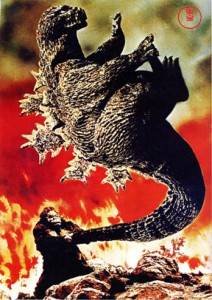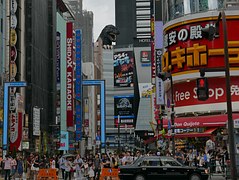By Lachlan Walter
Hype can be a terrible thing. Too much of it can induce familiarity and fatigue, so that by the time the ‘product’ arrives (the best of a bad word – the film/TV show/book/whatever) we’re already a bit over it and hence our desire to see or read it is diminished; too little can consign the product to obscurity, forcing it to live in the margins and reach only a cult audience. And then there is hype’s symbiotic twin: expectation. Too much hype can raise our expectations so high that they can’t possibly be met; too little means that our faith in the filmmaker or writer can be lessened. If they don’t believe in their product enough to thoroughly raise our expectations and make us excited to experience their story, then why should we bother with it?
Nowhere is the fomenting and creation of expectation more fraught than when a filmmaker or writer approaches a bygone fiction with the intention of re-presenting it for contemporary audiences, and there can be no more volatile bygone fictions than those that have transcended their genres to become pop-culture staples. In terms of science fiction, think of Star Wars and Star Trek, Dr Who, King Kong, and so on. These are fictions whose characters and ideas have become ingrained in our collective pop-culture consciousness: think of the fact that people around the world declare their religion as ‘Jedi’ or that the suffix ‘Zilla’ has been adopted to describe anything monstrous and unstoppable, most notoriously in the derogatory Bridezilla.
All of this brings us, in a roundabout way, to Godzilla (2014).
Expectations were immediately heightened when it was announced that Gareth Edwards, the director of the serious and thoughtful giant-monster movie Monsters (2010), would be making an American version of this pop-culture icon. There was a feeling that this version would be faithful and that it wouldn’t be a mockery, unlike the Americans’ first attempt back in the 1990s. These expectations were raised higher as its release date drew closer and the hype grew: set photos and teasers and trailers hinted at the potential of greatness, of a sense of scale and menace hitherto unseen. But Godzilla himself is quite a contradictory character, ranging from a destructive and vengeful symbol of humanity’s nuclear folly, to a child-friendly defender of the Earth whose high-kicks, wrestling grapples and karate-chops would be the envy of any MMA master. And so expectations weren’t just high, but were also scattered, unfocussed and ultimately self-defeating. There is no ‘one’ Godzilla, and so there can be no ‘one’ Godzilla movie.
It’s no wonder, then, that Godzilla (2014) polarised general audiences, fans and critics. Which is a bit of a shame, because looking back at it now that the hype has died down, Edwards’ take on this icon is insightful, subtle, serious, and truly respectful of the character’s sombre origins.
There are three distinct factors that I believe make Godzilla (2014) this way. The first of these is in the subtle insinuation that the appearance of both the MUTOs and Godzilla himself is directly caused by humanity’s interference, domination and despoliation of nature. While this link is a mainstay of Godzilla’s varying origin stories, it is usually explicitly made – after all, in the very first film of the series, he was revived from a frozen-sleep by nuclear testing. But by keeping these causal links subtle, Edwards turns the age-old theme of ‘man plays God’ into something fresh and interesting.
At no point do any characters come out and say that ‘this’ caused ‘that’ in a hand-holding attempt at filling in the blanks for us; instead, we our allowed to come to these conclusions on our own. This is helped along by Edwards’ three-pronged approach to embedding this theme. Firstly, he connects each successive phase of the MUTOs’ evolution and of Godzilla’s appearances with distinctly man-made environments, which we recognise through either direct or indirect experience with their real-world likenesses. Secondly, he juxtaposes these man-made environments with their more ‘wild’ surrounds, as a way of showing just how much environmental damage we can inflict. Thirdly, he shows us the aftermath of the MUTOs’ and Godzilla’s transit through these environments, which forms a further juxtaposition, this time between the environmental damage we can do and the environmental damage they can do.
A good example of this technique occurs in the opening scene, which takes place at an enormous mine deep in the jungles of the Philippines. At first, a wide-shot of the rolling, verdant jungle establishes the scene, which quickly cuts to the cabin of a helicopter flying over it and then cuts back. The deep green of the jungle suddenly disappears before an ugly blight of torn-open earth, towering cranes, flimsy bridges and access roads, all of which are collapsing into a deep cavern. Open inspection of this cavern, Dr Serizawa and his colleagues discover the fossilised remains of a MUTO, as well as two spores, one dead and one empty. The camera quickly cuts to the scene of the second spore’s escape: an enormous trench carved out of the earth on the far side of the mine that leads into the ocean, a trench whose environmental destruction is every bit as stark and total as that of the mine itself.
This technique is repeated time and again. The Janjira Nuclear Power Plant that becomes a food source for the first incubating MUTO is initially portrayed as a mess of smoke-stacks and towers that loom over a quaint peninsula township, and is then portrayed as the centre of a crumbling ghost town after the MUTO takes residence, a ghost town with deliberate echoes of the empty post-Chernobyl town of Pripyat. The Yucca Mountain Nuclear Waste Repository that provides a smorgasbord for the second MUTO to feed on when regenerating and hatching is first framed as a lonely hill in the desert, until we then realise that it is actually a hollowed-out hill, which we then see has suffered worse damage thanks to the MUTO’s explosive exit. The Hawaiian city of Honolulu, which plays host to the first confrontation between Godzilla and a MUTO, is initially obscured by the dense hill-jungle that surrounds it and then revealed to be a concrete-jungle whose high-rises line the beachfront, which is subsequently flooded by a tsunami caused by Godzilla’s landfall.
Each time, the pattern is the same: here is nature, here is what we can do to it, and here is what they can do to it. The implication isn’t just that their existence is our fault – if we hadn’t dug that mine in the Philippines, if we hadn’t built that power station or hollowed out that mountain, none of this would have happened – but also that we aren’t necessarily at the top of the food chain, and that our impact on the environment is no longer the most damaging. And so in accordance with the film’s logic, Godzilla truly is the ‘alpha predator,’ ruling over both MUTOs and mankind alike.
The way that Edwards’ depicts the monster size, and the way he creates a sense of scale, is the second factor that elevates Godzilla (2014) above its by-the-numbers brethren and stops it from being just another B-movie. Now, this might seem like a superfluous thing to say – it is, after all, a giant-monster movie – but size only matters if it’s used well and if it has something to say. Otherwise, it’s just eye-candy. Luckily, Edwards is a skilled enough filmmakers to be able to impart reflections of his narrative’s themes into his depictions of Godzilla and the MUTOs – the monsters in Godzilla (2014) don’t just do battle and lay waste to cities in an orgy of destruction that is all sizzle and no steak: these moments of action are filled with meaning and subtext, and add another textual layer to the narrative’s implicit messages.
Time and again, Edwards’ sets up two size comparisons in his various depictions of the monsters: a comparison between people and their ‘built’ environments, and a comparison between these environments and the monsters. In those scenes where the natural environment overshadows the built, a third size comparison enters the play: people with the built, the built with the natural, the built with the monster and the natural together. As an example of Edwards’ double comparison, we only need look to the ‘bridge scene.’ Here, Brody and a group of other soldiers are escorting a nuclear weapon that is being carried by a train; coming to a suspension bridge, they scout ahead to check that everything is safe – these scenes establish the first size comparison, between people and the train and bridge. Of course, a MUTO is lying in wait for the train, and it subsequently attacks the train and the bridge itself, which sets up the second size comparisons, between the train/train and the MUTO.
As an example of Edwards’ triple-comparisons, take the first ‘narrative’ appearance of Godzilla himself (his first appearance excluding the opening credits). We first see our characters at the bridge of a battleship. A warning comes to them: Godzilla is approaching, swimming underwater, and will pass beneath them. The characters duly head out to the deck, and the first size comparison is made: they are dwarfed by the infrastructure of the battleship, made tiny by this marvel of human ingenuity. The second comparison then occurs, as the battleship is framed against the empty and horizon-filling ocean. And then Godzilla passes beneath them, his tail and the fins on his back breaking the surface and causing the battleship to rise and fall. We don’t see any more of him than this, but it is enough to confirm his sheer enormity – just like between the battleship and the ocean, the comparison between Godzilla and the battleship is stark.
The meaning and subtext of this type of framing and this sense of scale is that despite all of our efforts – despite the grandeur of our cities and the magnificence of our machines – we are just ants compared to the monsters, and everything that we’ve made and built is just an anthill. Over and over again, people are shown being dominated by the environments that they have created, which themselves end up being dominated by nature and the monsters together. In other words, we are let down in the end by these things that we have created. Instead, these built environments – environments that, in many ways, have come to dominate the natural and act as self-erected monuments celebrating our pride – are now nothing more than playgrounds for the monsters and vacant land for nature to reclaim. Of course, the implication behind this meaning and subtext, once again, is that we are no longer on top of the food and that Godzilla truly is the ‘alpha predator.’
The third factor that elevates Godzilla (2014) is its unarguable sense of realism. This can be seen in a number of different ways: in the fact that Edwards at least tries to explain the origins of both the MUTOs and Godzilla himself, and to invest them with approximately-appropriate animalistic behavioural traits; in the sense of scale that Edwards conjures, as previously mentioned, and the level of ‘grit’ belonging to the destruction wrought; and in the way that both the MUTOs and Godzilla himself are often only seen either in glimpses or via screens, a reflection of the idea that characters seeing them first-hand would be more focussed on running away rather than taking a good look, while everyone else would be seeing them thanks to media and mobile footage. But perhaps the most interesting is in the way that Edwards positions his characters as determinedly ‘ordinary’ people. These men and women aren’t larger-than-life heroes; they aren’t supposed to just shrug off the awe and horror that Godzilla inspires, and they aren’t there to make a smart-arse quip before saving the day. The events that they experience affect them deeply and make them behave in ways different from the usual, and they react in much the same way that we would. This makes them a lot more relatable, fosters a genuine sense of empathy and connection, and helps anchor the more fantastical parts of the narrative.
The character of Brody is an excellent example of this type of ‘ordinariness.’ At first, he comes across as reasonably well-rounded: he is shown enjoying time spent with his wife and child, having being given leave from the military; and then shown expressing frustration and anger at his father’s obsessions and compulsions, and then a kind-of resigned acceptance when he is drawn into his father’s schemes. These are fairly ‘ordinary’ responses to these all-too-relatable moments. However, after the appearance of the first MUTO, Brody slowly develops a tendency to look a little blank-faced, to speak in a bit of a monotone, to obey orders almost automatically, and to pare his syntax back to its bare essentials, behaviours that eventually come to dominate his state of being. Now, this could chiefly be explained in one of two ways: bad writing and bad acting, or the realistic actions of a soldier in the field who has been trained to make split-second decisions without a second thought. When we take this line of thinking further and recognise the fact that Brody has found himself not only orphaned but also uncertain as to whether his wife and child are alive or dead, his stilted behaviour starts to make more sense. His slightly robotic movements, flat speech patterns and almost-instinctive reactions start to look more like a kind-of auto-pilot suffered by a soldier undergoing PTSD, a solider who has no choice but to keep on fighting.
A similar dual perspective exists when we look at the character of Dr Serizawa. His transformation from action-oriented character to one that looks on with glazed eyes and a slack jaw could again be attributed to overacting and bad writing, unless we consider the fact that he has suddenly had his life’s work vindicated in the most terrible of ways – he was the one in charge of studying the dormant MUTO, and it was this decision to study it rather than kill it that led to Godzilla’s awakening. If we can imagine what he would actually be feeling – the mixture of elation at being proved right, relief at finally finding an answer after years of searching, and horror at what that answer actually means – then his almost-complete blankness is actually a fairly appropriate and ‘ordinary’ response to what is happening.
Godzilla (2014) isn’t a perfect film (if such a thing as a perfect film even exists) – some of the dialogue is stilted and some of the acting is wooden, Edwards’ decision to somewhat obscure Godzilla himself rather than show him outright is sometimes taken too far, and its focus through a military perspective is somewhat limiting. But it is arguably an excellent giant-monster monster, one that becomes better with repeat viewings, especially now that the hype has died down.
Settle in front of the tube and watch it again, and keep in mind the above factors while you’re doing so. I can’t promise that this time it’ll make your socks go up and down, but it just might…





